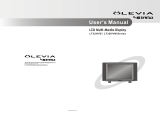
important Safeguards
Please read the following safeguards for your TV and retain for future reference. Always follow all warnings and instructions
marked on the television.
1. Read, Retain and Follow All Instructions. Read all safety andoperating instructions before operatingthe TV. Retainthe safety and operating
instructions forfuture reference. Follow alloperating and use instructions.
2. Heed Warnings. Adhere to all warnings on the appliance andin the operating instructions.
3. Cleaning. Unplug the TVfrom the wall outlet before cleaning. Do not use liquid, abrasiveor aerosol cleaners. Cleaners can permanently
damage the cabinet and screen. Use a lightlydampened cloth for cleaning.
4. Attachments and Equipment. Never add anyattachments and/or equipment without approval of the manufacturer as such additions may
result in the risk offire, electric shock or other personal injury.
5. Water and Moisture. Donot usethe TV where contact with or immersion in water ispossible. Do not use nearbath tubs, wash bowls, kitchen
sinks, laundrytubs, ina wet basement, swimming pools, etc.
6. Accessories. Do not place the TVon an unstablecart, stand, tripod, or table. TheTV mayfall, causingserious injury to a
child, adult or pet and serious damage to the TV. Use only with acart, stand, tripod, bracket or table recommended bythe
manufacturer,or sold with the TV. Any mounting of the TVshould follow the manufacturer's instructions, and should use
mounting accessories recommended by the manufacturer.
An appliance and cart combination should be moved with care. Quick stops, excessive force, and unevensurfaces may cause
the appliance and cart combination to overturn.
7. Ventilation. Slots and openings in thecabinet areprovided for ventilation andto ensure reliableoperation of the TV and to protect it from
overheating. Do notblock these openings or allow them to be obstructed by placing the TV on abed, sofa, rug, or other similar surface. Nor
should it be placed overa radiator or heatregister. If the TV isto be placed in a rack or bookcase,ensure that there isadequate ventilation and
that the manufacturer's instructions havebeen adhered to.
8. Power Source. ThisTV should be operated only from thetype of power source indicated on the marking label. Ifyou arenot sure of the type of
power supplied to your home,consult your appliance dealer or local power company.
9. Grounding or Polarization. This TV is equipped with a polarizedalternating current line plug havingone blade wider thanthe other. This plug
will fit into the power outlet only oneway. This isa safety feature. If you are unableto insert the plug fully into the outlet, try reversingthe plug.
Ifthe plug should still fail to fit, contact your electrician to replace your obsolete outlet. Do not defeat the safety purpose ofthe polarized plug.
f0. Power-Cord Protection. Power-supply cords should be routed so that they are not likely to be walked on or pinched by items placed upon or
against them, payingparticular attention to cords at plugs, convenience receptacles, and the point where they exit from the TV.
ff. Lightning. Foradded protection for this TV duringa lightning storm, or when it is left unattended and unused for long period of time, unplug it
from the wall outlet and disconnect the antenna orcable system. This will prevent damage to the TVdue to lightning and power-line surges.
12. Power Lines. An outside antenna systemshould not be located in thevicinity of overheadpower linesor other electric light or powercircuits,
or where it can fall intosuch power lines or circuits. When installing an outside antenna system,extreme careshould be taken to keep from
touching such power linesor circuits as contact with them might be fatal.
13. Overloading. Donot overloadwall outlets and extension cords asthis can result in arisk offire or EXAMPLEOFANTENNAGROUNDING
electric shock. _ii_ :_
14. Object and Liquid Entry. Neverpush objects of any kind into this TVthrough openings asthey _LAENTENNN_IRE
may touch dangerousvoltage points or short-out parts thatcould resultin fire or electric shock.
Neverspill liquid of any kind onor into the TV. _.TE._.....
15. Outdoor Antenna Grounding, Ifan outside antennaor cable system isconnected to the TV,be <.EOART,OLE81020)
surethe antennaor cable system is grounded so asto provide some protection against voltage _o_"o_s
surges and built-up static charges. 1021)
Article 810of the National Electric Code,ANSI/NFPA No.70-2002, provides information with _ POWERSERVICEGROUNDING
respect to proper grounding of the mastand supporting structure, grounding of the lead inwire to ELECTRODESYSTEM
NEC NATIONAL ELECTRICAL CODE (NEC ART 250, PART H)
an antenna discharge unit, sizeof grounding conductors, location of antennadischarge unit, con-
nection to grounding electrodes, and requirements for the grounding electrode.
16. Servicing. Do not attempt to service this TV yourself as opening or removing covers may expose you to dangerous voltage or other hazards.
Referall servicing to qualified service personnel.
17. Damage Requiring Service. Unplugthe TVfrom the wall outlet and referservicing to qualified service personnel under the following
conditions:
(a) Whenthe power-supply cord or plug is damaged.
(b) If liquid has beenspilled, or objects havefallen into the TV.
(c) If the TV hasbeen exposed to rainor water.
(d) If the TV does not operate normally byfollowing the operating instructions, adjust only those controls that are covered bythe operating
instructions asan improper adjustment of other controls may result in damage andwill often require extensive work by aqualified techni-
cian to restore the TV to its normaloperation.
(e) If the TV hasbeen dropped or the cabinet has been damaged.
(f) Whenthe TV exhibits a distinct change in performance - this indicatesa needfor service.
18. Replacement Parts. When replacement parts are required, be surethe service technician has usedreplacement parts specified bythe
manufacturer or havethe same characteristics asthe original part. Unauthorizedsubstitutions may result in fire, electric shock or other hazards.
19. Safety Check. Upon completion of anyservice or repair to the TV,askthe service technician to perform safety checks to determinethat the TV
is in safeoperating condition.
20. Heat. The product should be situated awayfrom heatsources such as radiators, heat registers, stoves or other products (including amplifiers)
that produce heat.





















